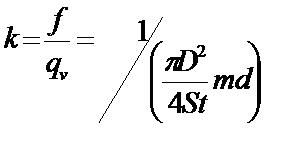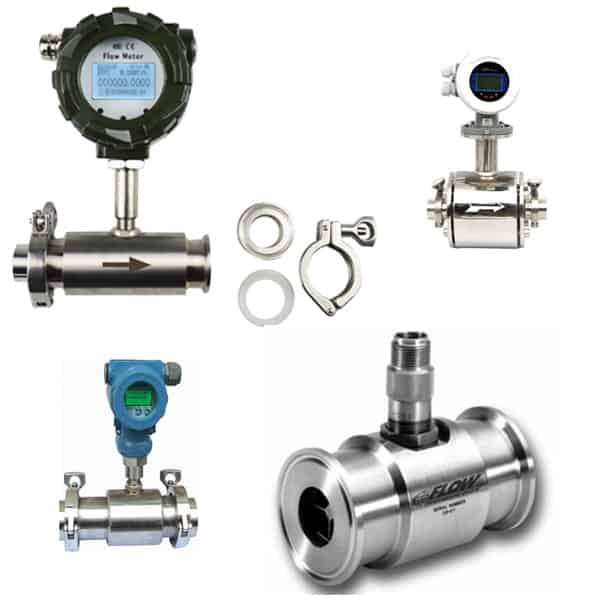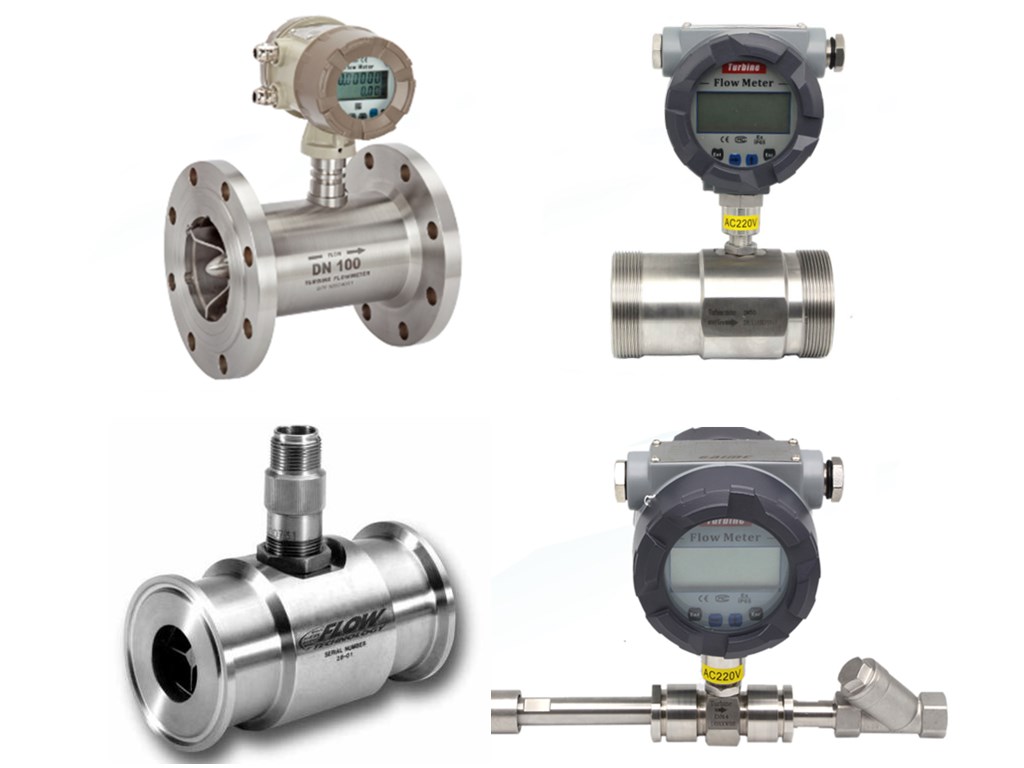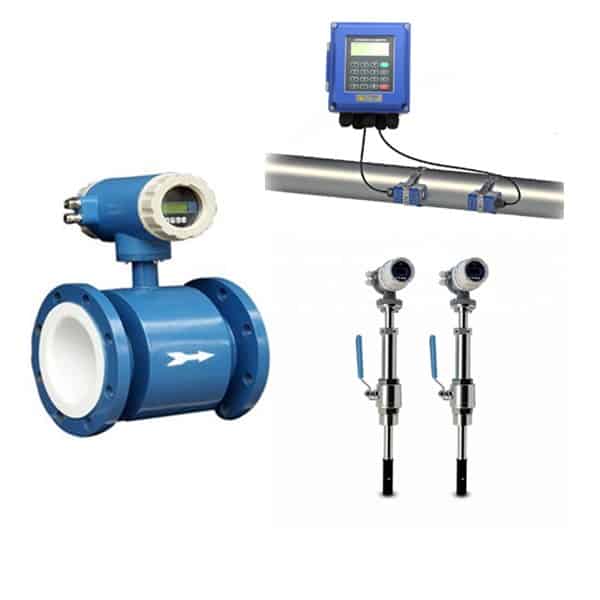
Liquid turbine flow meters utilize the mechanical energy of liquids to rotate a rotor within the fluid, measuring the rotational speed and thus the fluid flow rate. They are suitable for measuring the volumetric flow of low-viscosity liquids in closed pipes, such as water, diesel, hydrocarbons, and chemicals.
Sino-Inst’s liquid turbine flow meters utilize proven flow measurement technology and cover pipe diameters from DN2 ~ DN300. Easy to maintain and durable, these liquid turbine flow meters are a reliable and cost-effective option for high-precision flow measurement.
Features
Specifications
| Item | Data |
| Medium | Non-corrosive low velocity liquid without impurity,not suitable for gas/steam |
| Accuracy | ±0.1%,±0.5%,±0.2%(Optional) |
| Flange standard | GB/T 9119-2010, DIN, ANSI, JIS |
| Output | Pulse, 4-20mA analog output, RS485 (Modbus-RTU protocol), HART |
| Diameter and installation | Flange connection DN15-DN200 |
| Screw connection: DN4-DN50 | |
| Loose flange connection: DN4-DN200 | |
| Medium temperature | Default type T1: -20℃~+80℃ (Standard) |
| High temp. type T2: -20℃~+120℃ (OEM) | |
| High temp. type T3: -20℃~+180℃(OEM) | |
| Operation condition | Operating temperature: -20℃~+60℃ |
| Related humidity: 5%~90% | |
| Atmospheric pressure: 86kPa~106kPa | |
| Ingress protection | IP65 or IP68 |
| Explosion proof | Exia‖CT4 or Exd‖BT6 |
| Warranty | 1 year |
| Delivery | Approximately 3 working days |
Flow Range
| Diameter (mm) | 4 | 6 | 10 | 15 | 20 | 25 | 32 | … | 150 | 200 |
| Standard flow range (m3/h) | 0.04~0.25 | 0.1~0.6 | 0.2~1.2 | 0.6~6 | 0.8~8 | 1~10 | 1.5~15 | … | 30~300 | 80~800 |
| Extended flow range (m3/h) | 0.04~0.4 | 0.06~0.6 | 0.15~1.5 | 0.4~8 | 0.45~9 | 0.5~10 | 0.8~15 | … | 15~300 | 40~800 |
| Conventional endurance pressure | 1.6MPa | 1.6MPa | 1.6MPa | 1.6MPa | 1.6MPa | 1.6MPa | 1.6MPa | … | 1.6MPa | 1.6MPa |
Order Guide
In addition to regular products, we support customization
| SI-3202- | Note | ||||||||
| Diameter | DNXX | DN4~DN200mm | |||||||
| Converter Type | N1 | 24VDC,Pulse output,No display | |||||||
| N2 | 24VDC,Pulse output,No display,EX | ||||||||
| A | 24VDC,4-20mA output,No display,EX | ||||||||
| E1 | Battery power supply,No output,Digital display,EX | ||||||||
| E2 | 24VDC,Pulse and 4-20mA output,RS485,Digital display,EX | ||||||||
| E2+B | 24VDC+battery power supply,Pulse and 4-20mA output,RS485,Digital display,EX | ||||||||
| E3 | 24VDC,Pulse and 0-20mA output,RS485,Digital display,EX | ||||||||
| E3+B | 24VDC+battery power supply,Pulse and 0-20mA output,RS485,Digital display,EX | ||||||||
| E+H | 24VDC,4-20mA output,HART,Digital display,EX | ||||||||
| G5 | 220VAC,Pulse and 4-20mA output,RS485,Digital display,EX | ||||||||
| G6 | 220VAC,Pulse and 0-20mA output,RS485,Digital display,EX | ||||||||
| Accuracy | 10 | ±1.0%R | |||||||
| 5 | ±0.5%R | ||||||||
| Flow Range | S | Standard Range | |||||||
| E | Extended Range | ||||||||
| Body Material | S4 | SS304 | |||||||
| S6 | SS316 | ||||||||
| Explosion-Proof | BT | Exd II BT6 | |||||||
| NA | None | ||||||||
| Connection | THM | External thread,Apply to DN4~DN50mm | |||||||
| THF | Internal thread,Apply to DN4~DN50mm | ||||||||
| WAF | Flange clamp | ||||||||
| DXX | D16:DIN PN16 Flange;D25:DIN PN25 Flange | ||||||||
| AXX | A15:ANSI 150# Flange;A30:ANSI 300# Flange | ||||||||
| JXX | J10:JIS 10K Flange;J20:JIS 20K Flange | ||||||||
| Temperature | T1 | -20~+80℃ | |||||||
| T2 | -20~+120℃ | ||||||||
| T3 | -20~+150℃ | ||||||||
SI-3202 DN50 E2 10 S S4 BT D16 T2
① ② ③ ④ ⑤ ⑥ ⑦ ⑧
- ① Diameter: DN50
- ② E2:24VDC,Pulse and 4-20mA output,RS485,Digital display,EX
- ③ 10:1.0% of rate accuracy
- ④ S: Standard range 4-40m³/h
- ⑤ S4:SS304 Body Material
- ⑥ BT: Exd II BT6
- ⑦ D16:Flange DIN PN16
- ⑧ T2:-20~+120℃
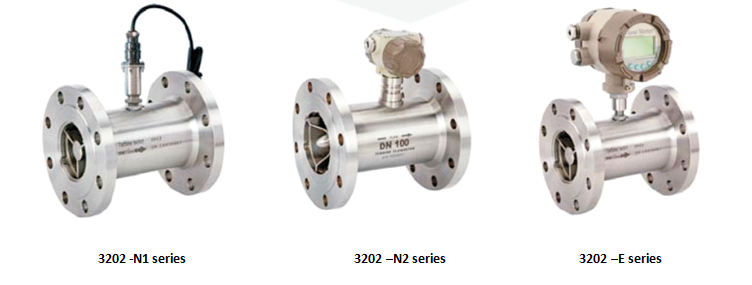
Liquid Flow Measurement
Turbine flowmeters are a type of velocity-based flowmeter with a moderate cost and are ideal for medium- and stable-velocity, clean, and low-viscosity fluids. They are used in the water, petroleum, and chemical industries. Water applications include distribution systems within and between water zones. Petroleum applications include custody transfer of hydrocarbons. Other applications can be found in the food and beverage and chemical industries.
- Only for single-phase fluids with low to medium viscosities:
Practical application and calibration have shown that when measuring low-viscosity fluids, the instrument factor of turbine flowmeters remains virtually unchanged with flow rate. However, as the viscosity of the measured fluid increases, the linearity of the turbine flowmeter deteriorates. The instrument factor also varies significantly with flow rate, making it difficult to achieve the desired measurement accuracy.
When measuring gas-liquid two-phase flow, the flow rate becomes highly unstable, resulting in significant measurement errors.
- The fluid being measured by a turbine flowmeter should be in a turbulent state:
According to the flow characteristics of a turbine flowmeter, the meter coefficient varies significantly with flow rate when the medium is in laminar flow, while the meter coefficient hardly changes with flow rate when the medium is in turbulent flow. To ensure the measurement accuracy of a turbine flowmeter, the measured medium should be in a turbulent state.
- Generally only used to measure media with high cleanliness requirements:
Most turbine flowmeters use spherical bearings, which place high demands on the cleanliness of the measured medium. Particulate matter in the medium will cause rapid bearing wear. Fiber matter can become entangled in the turbine blades, affecting proper rotation. In practical applications, an effective filter should be installed upstream of the turbine flowmeter.
Specific Applicable Media:
- Clean Liquids: Water, Beverages (Juice, Beer, Alcoholic Beverages), Dairy Products, etc.
- Petrochemical Media: Gasoline, Diesel Oil, Lubricating Oil, Hydraulic Oil, Liquefied Gas, etc.
- Chemical Solutions: Ammonia, Methanol, Brine, etc. Organic/inorganic liquids: alcohol, ether, benzene, formaldehyde, etc.
Technical Support
- Technology Guide to Turbine Flow Meters
- Technology Guide to Magnetic Flow Meters
- Technology Guide to Vortex Flow Meters
Sanitary Flow Meter
Sanitary Flow Meter, also called the tri-clamp flow meter. Sanitary Flow Meters have stainless steel bodies and come standard with Tri-Clover fittings. Sanitary flow meter meets the requirements of the food, and beverage company industries. Sino-Inst’s magnetic flowmeter and turbine flow meters is available in a sanitary version. And allows for use with Output Modules, Sensors and Remote Transmitters.
Turbine type flow meter
Turbine type flow meter is one type of mechanical flow meters. Turbine flow meter use the mechanical energy of the liquid to rotate a rotor in the flow stream. Turbine flow meters measure the velocity of a variety of liquids (oil, water), gases (natural gas) and vapors. All types turbine flow meters, like: flange, sanitary flow meter, insertion, threaded connections etc. .
Water Flow Meter Types
Water Flow Meters are flow meters measure and show the flow rate of water flow. Water flow measurement is important for inductrial applications, like the wastewater treatment. In principle, water flow meter types are: Electromagnetic (magnetic), Turbine, Ultrasonic, and DP. Coriolis and Oval Gear flow meters can also work for water flow measurement. These water flow meters, optional with digital display, battery, analog or pulse output. Material can be 316 stainless steel or special material.
Wastewater flow meter
Wastewater Flow meters are flowmeters for water and wastewater treatment. Electromagnetic flow meters are suitable for open channel and underground industrial water pipes. Magnetic flow meters can be Remote type, compact type, insertion type. And ultrasonic flow meters are another choice, if you can not change your pipes. Both ultrasonic flow meters and magmeters are inline flow meters. Sino-Inst offers ultrasonic and magnetic flow meters, which offer the highest flow meter accuracy and reliability, as well as long-term stability and a low cost-of-ownership.
You may like:
Natural Gas Flow Meter
Steam Flow Meters
Digital Water Flow Meter
The Sino-Inst liquid turbine flowmeter features a simple, lightweight structure, high accuracy, excellent reproducibility, and sensitive response. It is widely used to measure liquids in closed pipelines that are less corrosive and free of impurities such as fibers and particles. At operating temperature, it can be used directly with liquids with a kinematic viscosity less than 5×10-6 m2/s. For liquids with a kinematic viscosity greater than 5×10-6 m2/s, the flowmeter can be calibrated with actual liquids before use.
Sino-Inst’s liquid turbine flowmeters can also be paired with display instruments with specialized functions. They can also provide quantitative control and over-flow alarms, making them ideal instruments for flow measurement and energy conservation. If you require a liquid turbine flowmeter or have any technical questions, please feel free to contact us!
-1.jpg)
